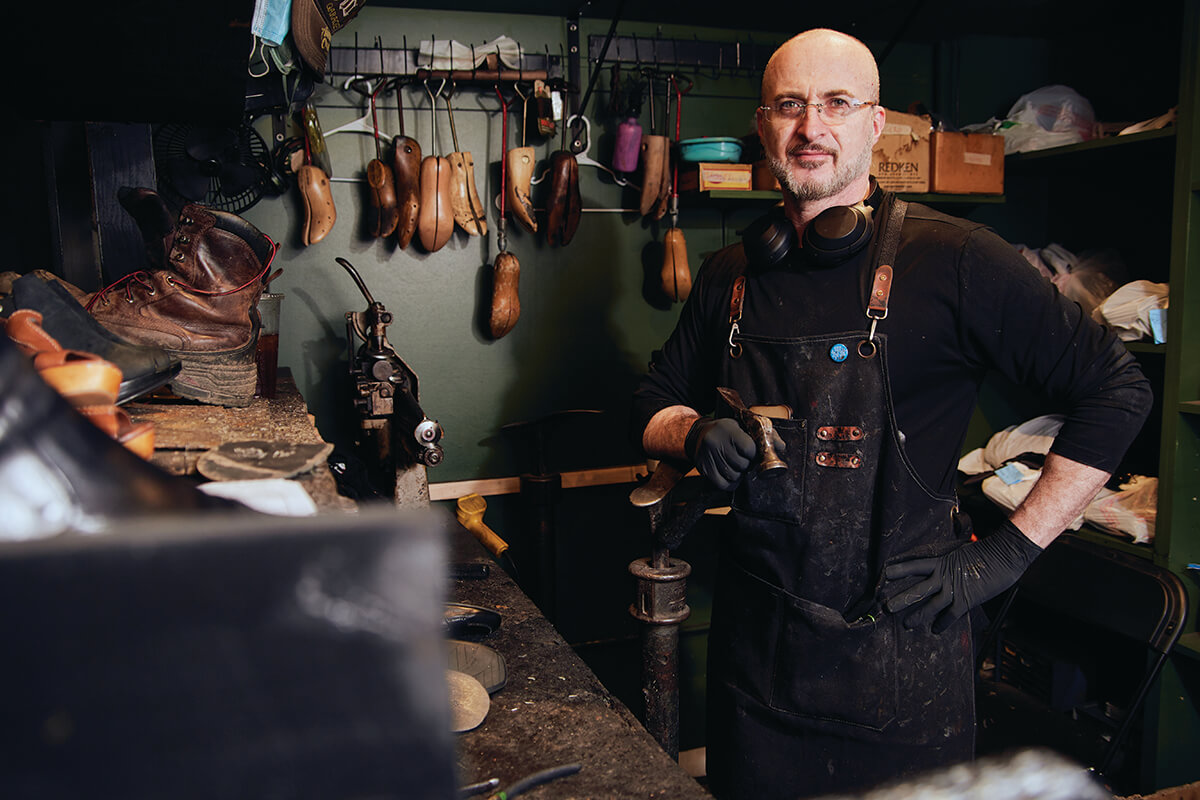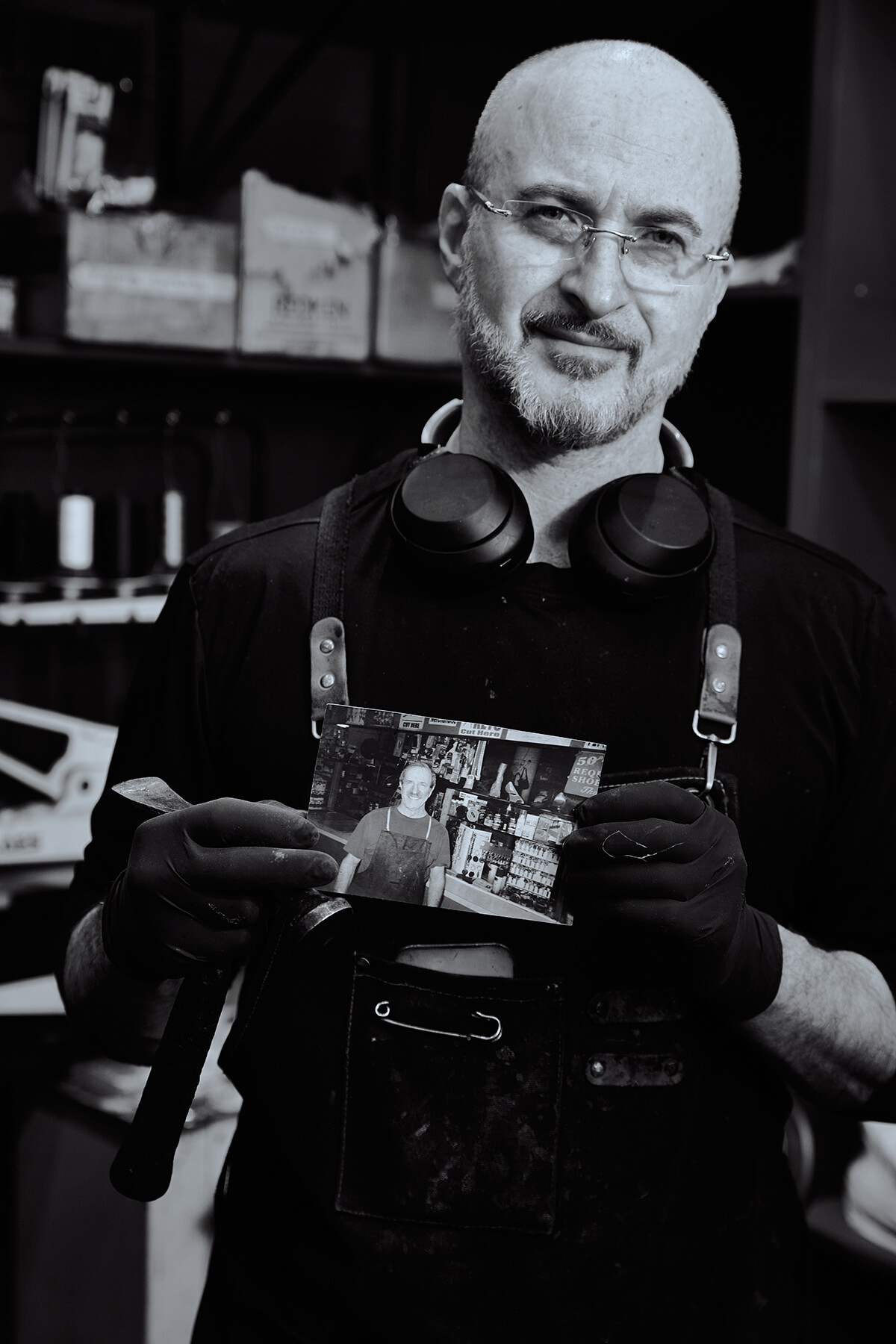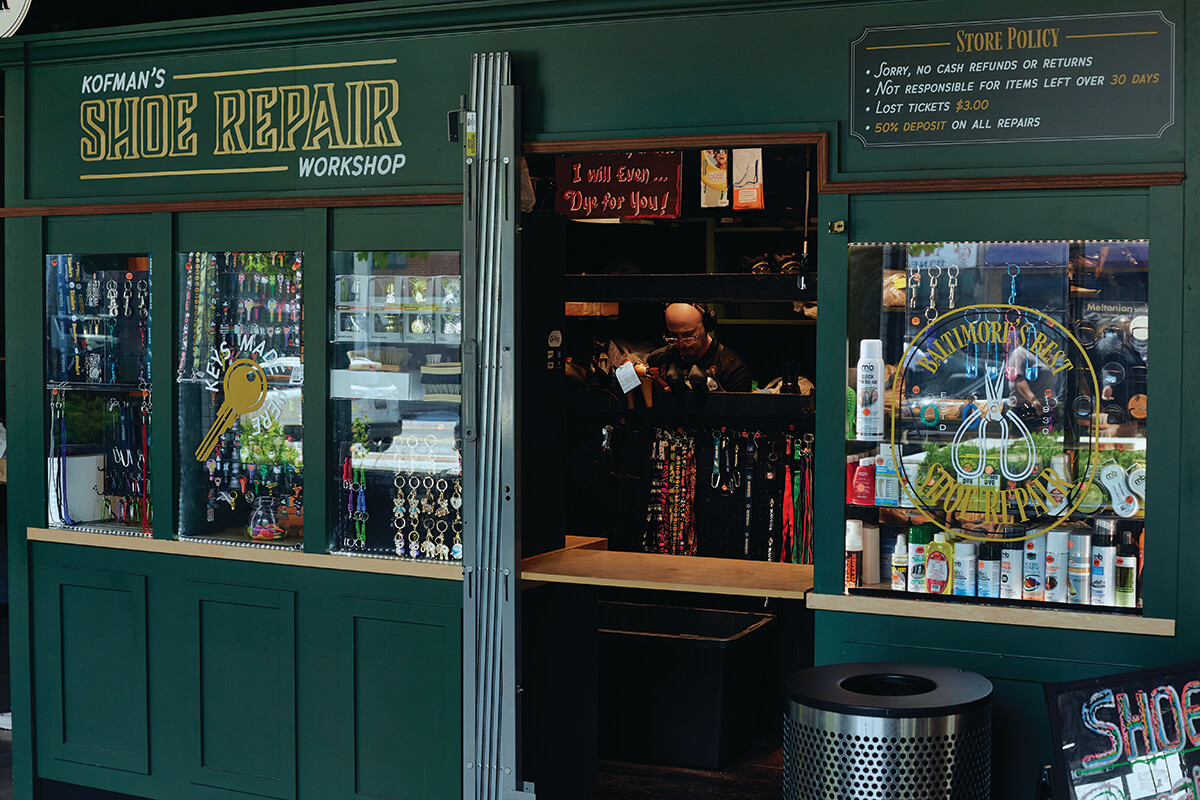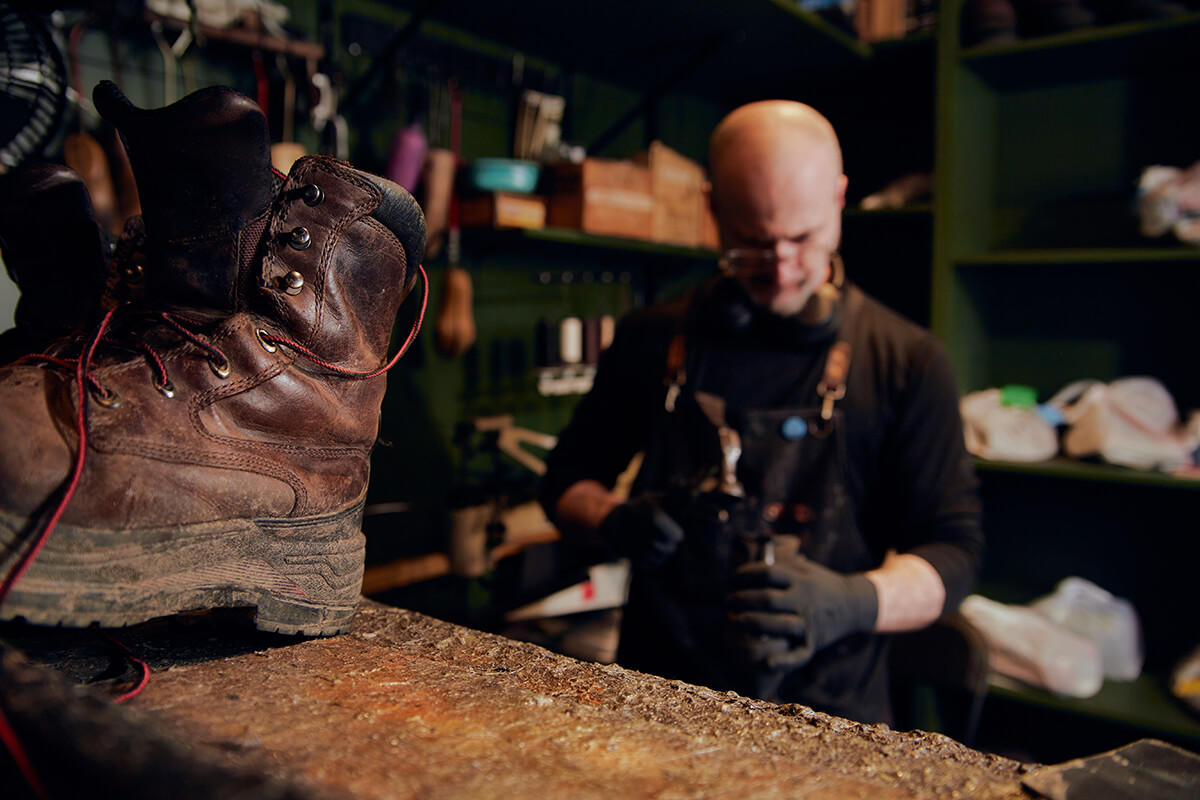News & Community
Kofman’s Shoe Repair Gets a Reboot at Lexington Market
Step inside the revived workspace of fourth-generation Baltimore cobbler Alex Kofman, whose age-old profession is going through a bit of a renaissance.

Walk down the steps to the lower floor of downtown’s Lexington Market, the oldest public market in the country, past the seemingly permanent line for the house-made Berger cookies at a 50-year-old bakery, and you’ll find Stall 19, the 203-square-foot shop that houses Kofman’s Shoe Repair.
Nearby, a uniformed cop chats with locals by the tall windows looking out onto Eutaw Street. And inside the tiny cobbler’s shop, wearing his customary black canvas apron, stands Alex Kofman, 54: shaved head, goatee, kind eyes behind rimless glasses, sound protecting earmuffs around his neck like some sort of steampunk jewelry.
There’s been a shoe repair shop at Lexington Market for nearly 100 of its 240 years. In 1979, Kofman’s father, Boris, took over a small stall in the back of the old market from its previous tenant, also a shoe repairman, who’d been there since the 1930s. (In the early ’90s, Kofman’s Shoe Repair was awarded Best Shoe Repair Shop by this magazine.)
Boris retired, at 78, just a few years ago. Kofman’s current stall dates to the summer of 2022, when the storied public market got a $45-million renovation and redesign.
And though Kofman’s new shop is light-filled and freshly painted, the interior looks like a century-old mechanic’s garage, with repeating boxes of metal hardware, pliers and hammers of various sizes, bits and pieces of leather, spools of laces, old wooden shoe stretchers that look like fairy-tale prosthetics, and shoes—pairs and pairs of wing tips, men’s leather dress shoes, high heels, and work boots—filling shelves and cubbyholes in every part of the little shop


The Kofman family first came to America 45 years ago. Alex’s father, Boris, and mother, Frida, immigrated from Kiev, in what was then Russia and is now war-torn Ukraine, in the late 1970s and, a decade later, his grandparents came over, too.
“We were all supposed to leave together as a family, but they got held up at the last second due to some paperwork,” says Kofman. “Ten years later, they joined us.”
The Kofmans came to Baltimore because they needed a sponsor and had a relative already living here. (The other option was San Diego, where another cousin lived; it’s a decision the family still jokes about, especially when Baltimore gets hit with a snowstorm.) As soon as his parents got to Baltimore, Kofman’s father opened the stall in Lexington Market.
Kofman is part of a declining profession, a fourth-generation cobbler whose business likely stops when he does. He has a 10-year-old son, Kelly, but, Kofman says, “I’m pushing him in the direction of working more with his head than his hands.”
Training someone else to learn the craft, never a strong option in this country, isn’t in the cards either. “I used to see maybe 10 guys come by a year to apply for a job, but that’s dwindled to nothing,” Kofman says. “All the older guys are either retiring or passing away. And there’s no new ones picking up the hammer.”
Customer demand is still high, as shoes still need to be repaired, though increasingly people are replacing rather than repairing their shoes.
“We are the oldest recycling business in the world,” says Kofman of the craft, which he learned from his father, who learned from his father, who learned from his father. (Kofman’s maternal grandfather was also a cobbler.) Kofman never met his father’s grandfather, who owned a shoe repair shop in Kiev, “but I saw pictures of him holding the hammer.”
Jigsawed into his small shop are machines from the 1920s and ’30s that Kofman inherited from his father or had been in the previous shop. One machine is new, because the version from the old shop didn’t fit into the new space. Although people do still make shoe-repair machines, the older ones—made out of steel and able to last half a century—are better, Kofman says, even if you do have to find a specialized mechanic to fix them.
Kofman began working at his father’s shop in 1989, when he graduated from high school. “When I first started, I remember there was a [shoe repair] shop on pretty much every corner,” he says. “And now you’ll struggle to name three in the city.” He pauses, doing an inventory in his head: “There was one around the corner from here; the gentleman passed away. There was another one that closed down after COVID. After COVID so many people I know just retired.”
“WE ARE THE OLDEST RECYCLING BUSINESS IN THE WORLD.”
In the 1930s, there were maybe 100,000 cobblers in this country. At the turn of the 21st century, that number had fallen to 15,000 and today there are only about 3,500 left.
“World War II was kind of the peak of the shoe repair industry, because leather and rubber were rationed for the war effort and people had no choice but to get their shoes repaired,” says Mitch Lebovic of the Shoe Service Industry of America (SSIA), which was founded in 1904 and based in Baltimore for decades before moving to suburban Chicago. Of those 3,500, there are about 75 in the state of Maryland.
Lebovic says the profession is more prevalent along the eastern United States, where immigrants first settled and opened generational
family businesses. He says that one of the challenges facing the industry today is that there isn’t really anywhere to learn the craft, no training facilities or schools that teach shoe repair. There are a few programs in community colleges and the like, but hardly enough to fill the gap left by retiring cobblers.
“So if you want to get trained in shoe repair,” he says, “your best bet is to catch on with somebody who is looking to retire and spend a couple of years basically being an apprentice.” Lebovic confirms there’s definitely still a need. “Most of the shoe repairmen that I talked to, at least the ones that do good work, are four to six weeks out with their work, which means they’re a little bit overwhelmed.”
Kofman’s father was one of the many shoe repairmen who retired when the pandemic hit. Stanley Ewell, the cobbler who had worked with both Kofmans since Alex was a kid, and who learned the trade himself when it was taught in high school, passed away last year, working up until the end. Which is why Alex Kofman now helms his shop, six days a week, by himself.
Kofman, who arrives early by train from Owings Mills, where he lives with his family, and often heads home after sundown, says the new stall is a vast improvement over his shop’s previous location in the old Lexington Market.
“We were so deep inside of the market, hidden around different corners, that up until the last day there, somebody would come by say, ‘Oh, I didn’t know there was a shoe repair shop here,’” he says, smiling.
Where they were before, weeks would go by when he wouldn’t see sunlight—as there were no external windows, “just recirculated dust.”
The new shop not only has plenty of light, but an exhaust hood as well. And if it looks like a restaurant-kitchen hood, that’s because it is.
“A lot of shoe repairmen, their health falls by the wayside because they never wore masks,” says Kofman, who started wearing masks long before the pandemic. He says that when he was a teenager, a woman who was probably a nurse at one of the nearby hospitals told him to wear not just a regular mask but a N95 mask to protect his lungs from all the dust in the shop, something he’s still grateful for.
“You’d come in and there would be an inch of dust everywhere,” he says of the early days. He’s also worn ear protection since he started: “I consume more podcasts per day than a person should be allowed.”
As he talks, he’s hammering the sole of a black leather boot at a table that’s older than he is. Next to him, an inverted metal foot form is attached to the ledge—think Cinderella’s famous shoe-fit scene as envisioned by Terry Gilliam. Also wedged into the space is a big machine from the ’50s that trims the soles of the shoes and looks like the head of an iron dinosaur. (“It is a dinosaur,” says Kofman of the old machine.) There’s an auto-soler that’s about 100 years old and a ’30s-era Sutton Landis stitcher resembling an outsize sewing machine.
“Maybe one company in America makes them,” he says, studying the tool. “They cost about as much as a cheap car.”
Kofman didn’t learn shoe repair in high school, but he didn’t have to, as his father taught him the craft in the family shop. “I remember thinking about trying out different things,” he says. “But I’d done this for so long—my father would watch me in the shop during the summers, and you naturally play with what’s around you—and I thought, Why invest time learning something else when I already know this? And I enjoy it,” he adds.
Kofman worked with his father for a while, then went out on his own, opening a separate shop on St. Paul Street for about five years, then another shop in Mondawmin Mall in the late ’90s. Then he came back to work with his dad until Boris retired in 2021.
In addition to the Lexington shop, the Kofmans have always had other pick-up spots around the city, businesses where people can drop off shoes for repair—the dry cleaners and shoe stores that are the natural waystations for folks who need their shoes fixed—as well as a downtown men’s club, though “not that type of men’s club,” Kofman says.
Towson Bootery is one of those shoe stores. Alex Rudolph, 75, now owns and operates the store, which his father opened in 1948 on York Road before moving to Kenilworth Mall in 1996. When Rudolph relocated his store, he gave most of his father’s old shoe repair equipment away and began working first with Boris Kofman, then his son.
“He did every kind of thing you could ask for in the shoe repair business,” Rudolph says of Boris. “What’s better than offering shoe repair in a shoe store? Shoe repairing is a dying art.”

The nostalgia of his profession is not lost on Kofman, especially having worked at Lexington Market for so many years. “Years ago, when the circus used to come to town, they brought in their shoes,” he says of the Ringling Bros. and Barnum & Bailey circus that performed at the Civic Center for most of the last century.
Kofman says that the market employees would go up to the roof of the market to watch the spectacle. “They’d bring elephants to the parking lot.” And the entertainers would bring their shoes to Kofman’s shop to get fixed. “Clown shoes. The performers would bring sheets of rubber in different colors to give them height.”
And while the circus no longer comes to Baltimore, Kofman still gets shoes from the performers at nearby Hippodrome Theatre. “Wicked had toes that curled up; I had to redo the bottoms.”
While both Lexington Market and Kofman’s repair shop have gone through a reboot, it’s unlikely that Kofman’s centuries-old craft will suddenly begin attracting a new generation of cobblers. It is, however, going through a bit of a renaissance, thanks to a revived interest in artisans and their crafts, such as beer-making and bread-baking. This renaissance “is not so much from a need,” says Lebovic, “but from a standpoint that they’re interested in the craftsmanship that goes into it.”
Though this interest doesn’t translate into shoe-repair classes or apprenticeship programs, it is making ripples on social media. Lebovic points to several shoe repairmen who have developed unlikely followings on TikTok and Instagram, just by posting videos of what they do.
“I have a friend from Florida who has I think a million followers on TikTok,” he says. “I mean, just from minute-long videos of him fixing
a shoe.”
Kofman doesn’t have his own social media, much less one for his shop, but he keeps busy. He’ll have plenty of work, he says, “as long as people wear shoes.”